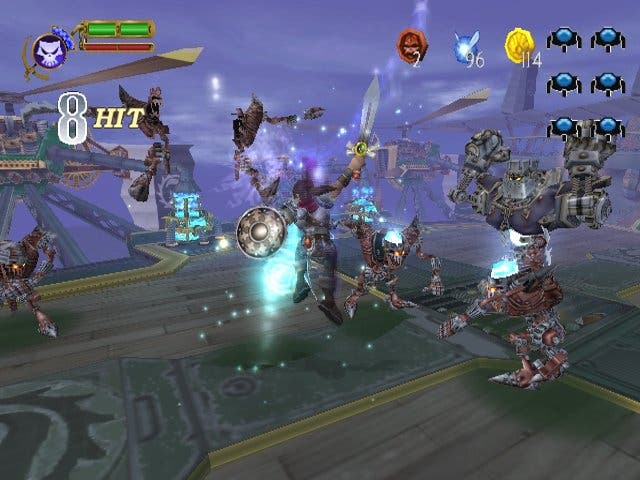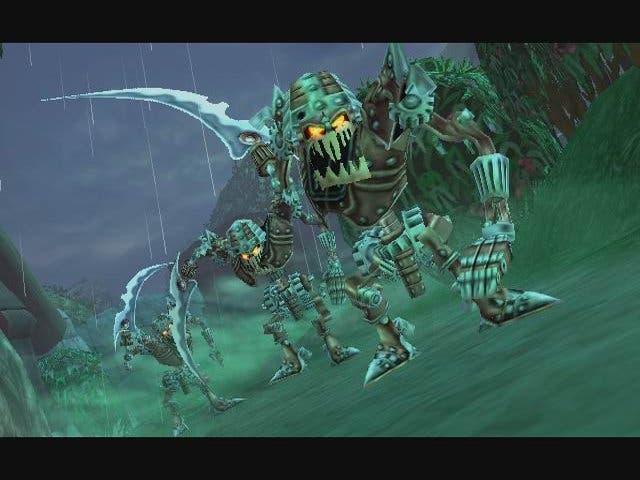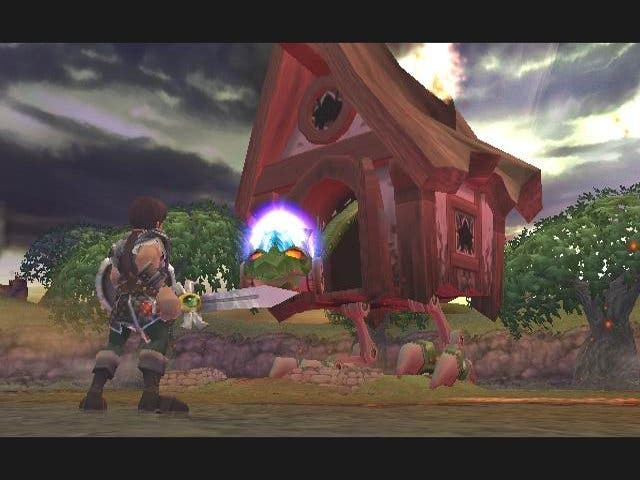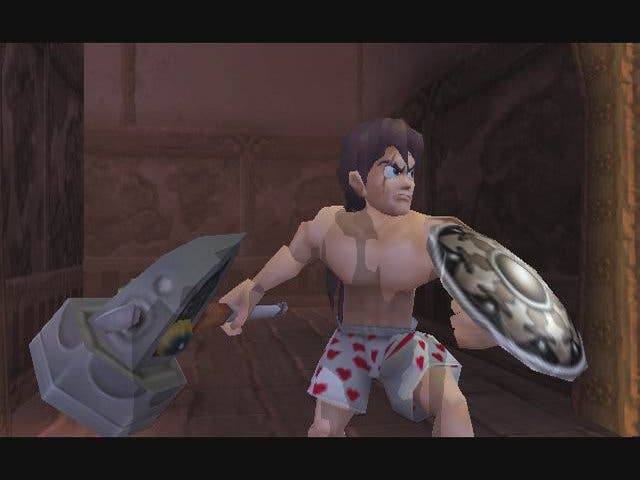Maximo Vs. Army of Zin
Tom gets to grips with a Japanese copy of the Maximo sequel.
Capcom may be heading in a new and slightly more bankable direction these days, developing a game based on The Nightmare Before Christmas and even installing Jean Reno opposite the Japanese hero of Onimusha 3, but we do hope it never stops turning out games like Maximo. When the obscure little third person platformy hackandslash arrived in 2001, it dragged the Ghouls & Ghosts series into the so-called "next generation" with aplomb, giving us a hero who fought a vicious difficulty level right down to the hilt (and his trademark pink polka dot boxers). In a lot of ways it was formulaic, repetitive and it was occasionally unfair, too, but it was also an inexplicably addictive, charmingly kleptomaniacal affair designed to lure gamers into that fabled "one more go" every time the grim reaper came a-knocking. (Or at least every time you had a red skull coin to pay him off with.)
Ghost in the shell

With that in mind, it won't come as much of a surprise that your import-mad correspondent snapped up Maximo Vs. Army of Zin (or Maximo 2 to save some typing) as soon as possible after its Japanese release, and despite being robbed blind by those Customs bastards (death to all of them!) en route, I finally got my greedy little hands on it on Monday morning, and got well and truly stuck into it the same evening whilst chewing over the rubbery crust of a take-away pizza.
As those of you who made it all the way to the end of Maximo without ripping your eyes out in anger and frustration will know, our hero still hasn't been reunited with his girlfriend Sophia, the lass whose disappearance prompted his desolation and sword-slashing antics in the first game. And despite an alliance with Grim (Death), he's still been unable to find her in the interim. In a scene setting opening cinematic, Grim tells Maximo that he's scoured the depths of the underworld and still can't locate Sophia's soul. Whatever to do?
Fortunately Maximo is able to keep busy when a horde of mechanised clockwork monstrosities start terrorising a nearby village, slaughtering its citizens and setting fire to their homes. As it turns out, these pestilent metalheads are being powered by the enslaved souls of formerly decent folk. Enraged by this, Maximo sets out to try and undo the carnage, and perhaps - just maybe - he'll find himself rescuing Sophia from the mangled ruins of a mechanised killer along the way. Who can tell?
Slash me happy

Maximo 2 gets off to a good start by keeping much of what made the original game good and just expanding on it. The world and character designs, for example, are once again the quirky and stylistic work of Japanese illustrator Susumu Matsushita (who is also currently working on the "Ninjya" game for Capcom), and they continue to breathe life into what is otherwise a fairly conventional PS2-era engine.
Just glancing over the top of my laptop at the game paused in front of me, the sharp and jagged scenery of the early haunted forest section (I'm trying to tot up my percentages, see) is given a new lease of life by wooden fenceposts that jut out of the ground at odd angles, simple overlapping branches and leaves that each draw from a narrow band of colours to create the illusion of depth, shade and variety, and numerous iridescent light sources punctuating the gloom. Trees look like they're snarling, dark forces carve harsh warnings into wooden barriers as I stroll past and there's little Maximo standing in the middle of it, chest heaving and sword clutched at his side like the bravest of Saturday morning cartoon heroes. There are times when it all seems a bit too obviously PS2, like the early village section with walls of rather unconvincing flame and oddly contoured, octagonal shrubbery, but you rarely think "that looks crap". If anything, Maximo's visual flaws are what make it endearing.
And speaking of the little chap, not to mention his legions of enemies, their stylish designs are matched by some terrific animation. Despite introducing what are effectively robots into a dark and faintly gothic fantasy setting, Matsushita-san has still managed to keep to the game's unique visual style, with enemies whose crushed souls throb encased in their mechanical surroundings, gears and cogs whirring and clanking as scythe-like weapons are thrust and blocked by our hero. The closest comparison to these chaps visually that I can think of are probably those stony bad guys at the end of The Mummy who clobber the freshly reanimated remains of that bald chap's former lover. They're a lot smarter, too. Although the requisite sword fodder obviously makes it in, after a while most enemies require thought and consideration to dispatch without hurting yourself - more so than ever before anyway.
Rabbiting on

Maximo himself, of course, is still an amiable, scarfaced knight literally in shining armour, and as before if he loses enough health he's gradually stripped down through several layers of armour and left in bare-chested in his skimpy pink boxers. His various attacking, defensive, running and jumping animations are a bit smoother than they were before, and there are also more of them - this time, for example, Maximo often sticks his sword into a surface he just failed to jump up to, allowing him to hang there and then jump and double-jump his way from this position up to the top.
Actually playing the game will feel familiar to fans of the original and Maximo's new attacks, weapons and abilities will also come naturally before long. Significant additions include the impressive combo system, which tallies up hits and rewards varied use of the horizontal (square) and vertical (slashes), without chucking too many of the original Maximo's trademark satisfying moves out of the way (the triple jumping downward stab attack is still as powerful and thunderous as ever, and Maximo's shield can still be thrown around like a boomerang). This time Maximo will also get a chance to upgrade his trusty sword into something else, obtaining a rather smashing hammer early on and, I'd imagine, more varied implements later in the game. Weapons, armour, boxers and other items can be switched between and put to use on the Inventory screen (Select), not to mention upgraded or replaced whenever Maximo happens upon a wandering salesman. (Often just after he's rescued him from certain death.)
Indeed, much of the same mechanics return here - you're still looking for keys, which are found in chests, downed enemies, and given to you by rescued villagers, you're still carving up as much of the scenery as possible and scouring every nook and cranny of each of the game's mostly linear levels for those handy gold coins, and you're still going back through levels to try and tot up your percentages. You can also expect villagers to reward you for saving them with a handful of coins, and if you're particularly mean you can ransack their house while they're standing around embracing the euphoria of freedom, and even slaughter their pet rabbits (although they do have this tendency to chase you around and hang onto your leg like an angry pit bull if you don't finish them off first time).
Hop, skip and jump

Maximo still has a lot of platforming to worry about, too. Often it's actually fairly simple just to get from one spot to the next, but it's the desire to collect all those coins, keys, flagons of health-boosting liqueur and death coins hanging around in mid-air that complicates matters. One early section set in a burning building puts you on the floor on one side of a room and shows you the exit at the top of the other side. In between you and the way out stand numerous platforms, disintegrating rafters and beams and a big lighting array swinging back and forth with every crackle and flare. You could just take the staircase up to your right, jump onto this lighting thing, jump to the other side, climb the stairs and hop out of the window. On the other hand, you could race between all the lower level platforms scooping up the goodies, use the swinging chandelier whatsit to make your way to different shreds of the first floor still hanging from the wall and collect all their treasures, and then finally leap from the top-most platform into the centre of the room and double-jump back to safety - having scooped up a key suspended in the air above a fall to certain death. Classic Maximo.
There's a lot of that, and there's also a lot of combat. It feels a lot smoother to my weathered paws (the camera is still silky smooth too, responding to everything you ask of it with the right analogue stick and rotating smoothly back to centre when you press L1), and the combos help, but when Maximo is running really low on health and has a few souls totted up, he can now turn to Grim for one last ditch attack. Pressing L1 and R1 together will summon the reaper, who is impervious to attack and rains death with his scythe the likes of which even these soul-pilfering clockwork lunatics probably couldn't envisage - which is why his presence is limited by how much juice you have in your "Grim meter" in the top left. As you'd expect, you can expand this as the game goes on, much as you can anything else in the game - including the contents of Maximo's underwear drawer.
Well Armed

After several hours in Maximo's company, any buyer's remorse I might have been nursing since I flung so much cash at him has quickly evaporated. The Japanese version is perfectly easy to play through, thanks to mostly English menus, a few web translations of the bits I didn't understand (now I can centre the screen!) and cut-scenes and voice acting played out entirely in English. It's a good thing Capcom has done that, too, because it adds some humour to the otherwise quirky and serious-sounding characters. The dialogue isn't going to win any awards, but it does raise a smile - Maximo telling Grim he's late, and Grim quipping that he "always turns up... in the end", for instance.
In fact, the only slight concern I have at this stage is that I'm actually making pretty steady progress! Despite slipping up a few times on the first boss (a giant, demented, mechanical, minigun-toting chicken who wears a barn for half the fight), it took a while before the game started chopping me down with comforting regularity, with progress eased by regular checkpoints and the ability to save on the map screen at no cost to the player, unlike last time when keeping track of progress often cost mucho gold. Give me a few more hours though and I'm sure I'll be swearing merrily as usual.
According to Capcom's latest release schedule, Maximo Vs. Army of Zin is due out in Europe on Friday, February 13th. In sales terms, we hope it has a bit more luck than the first game, which sold something like 35,000 copies in the UK, but based on what we've seen it's more than likely to appeal to folks who lapped up the first one, and with a little education plenty more besides.

